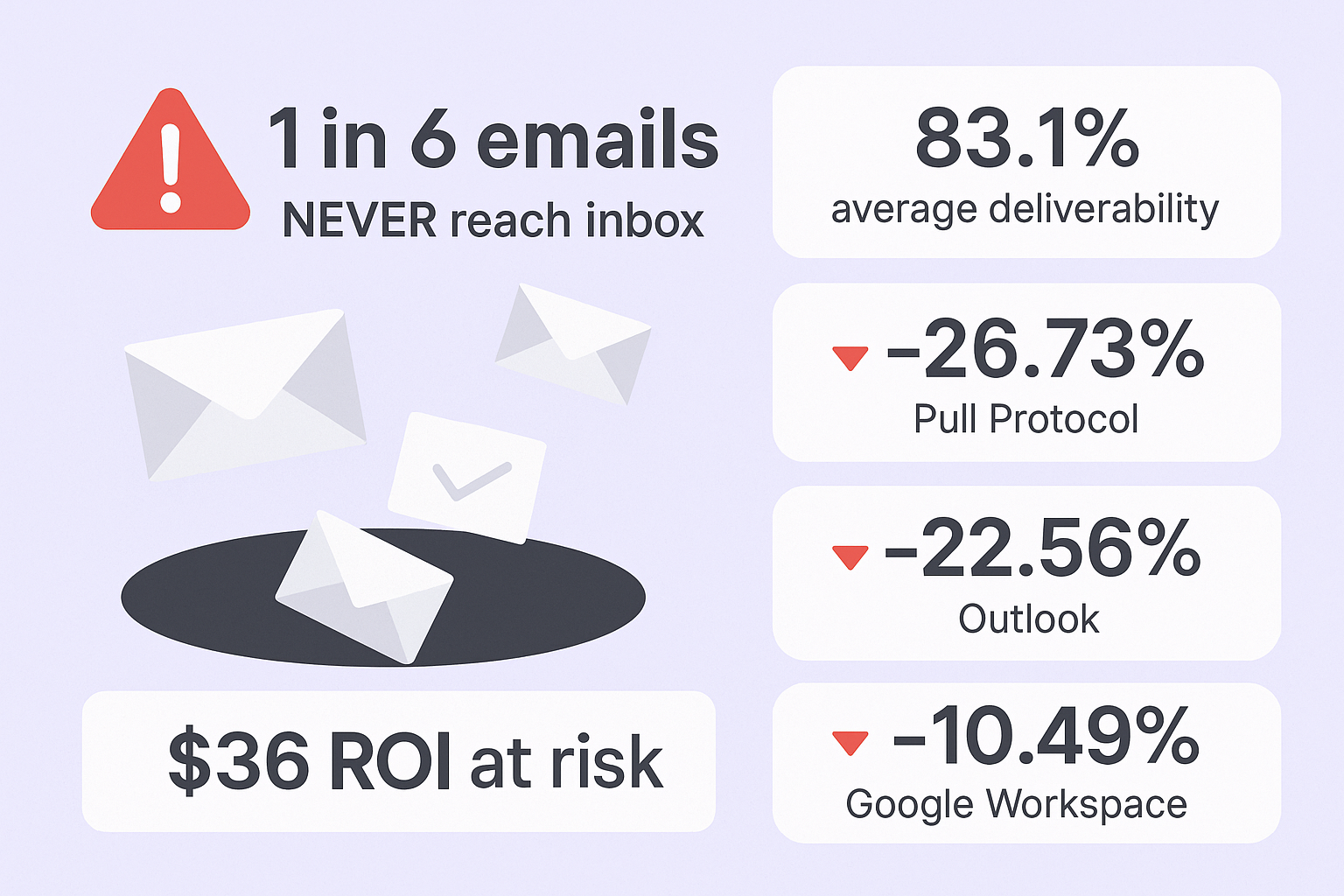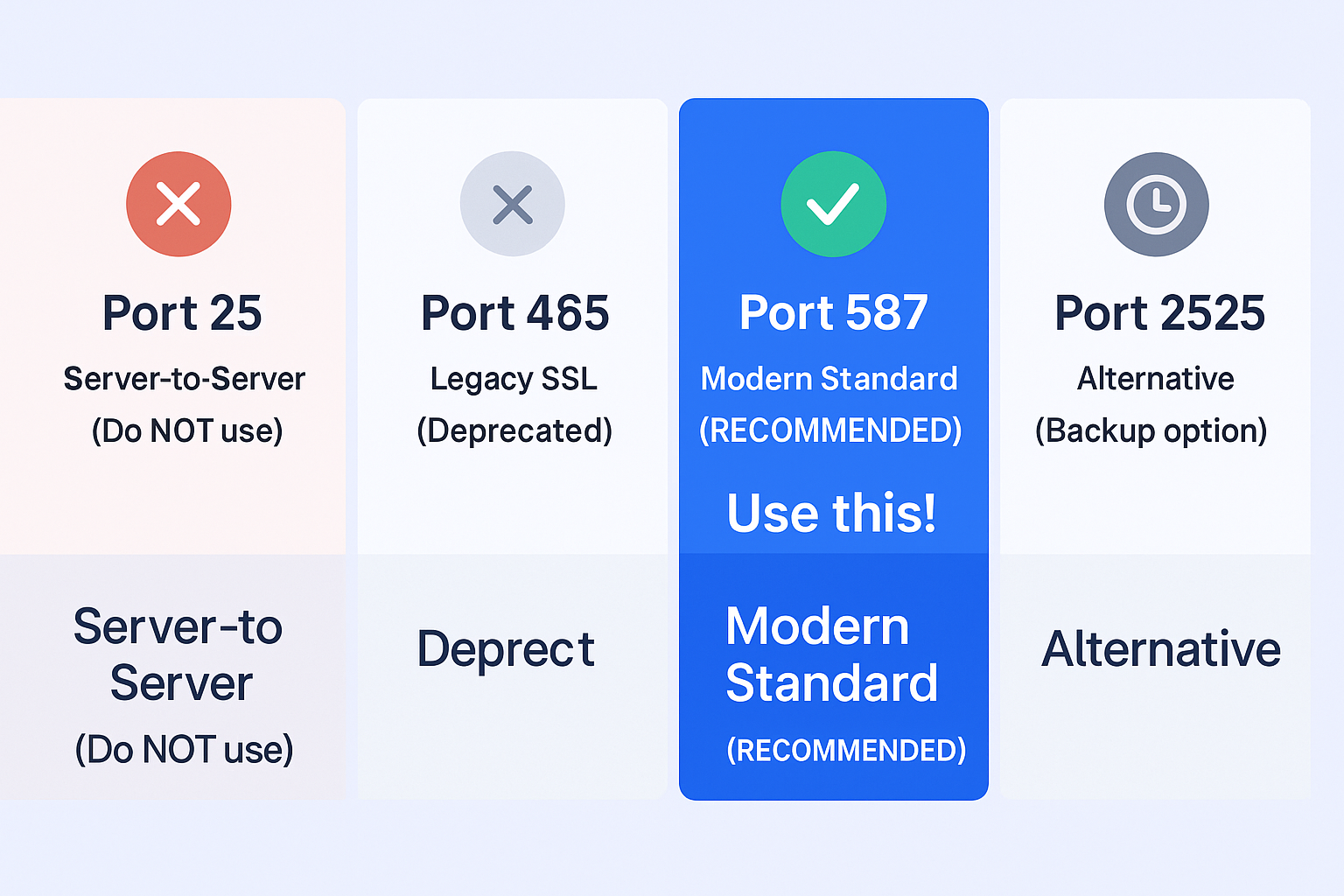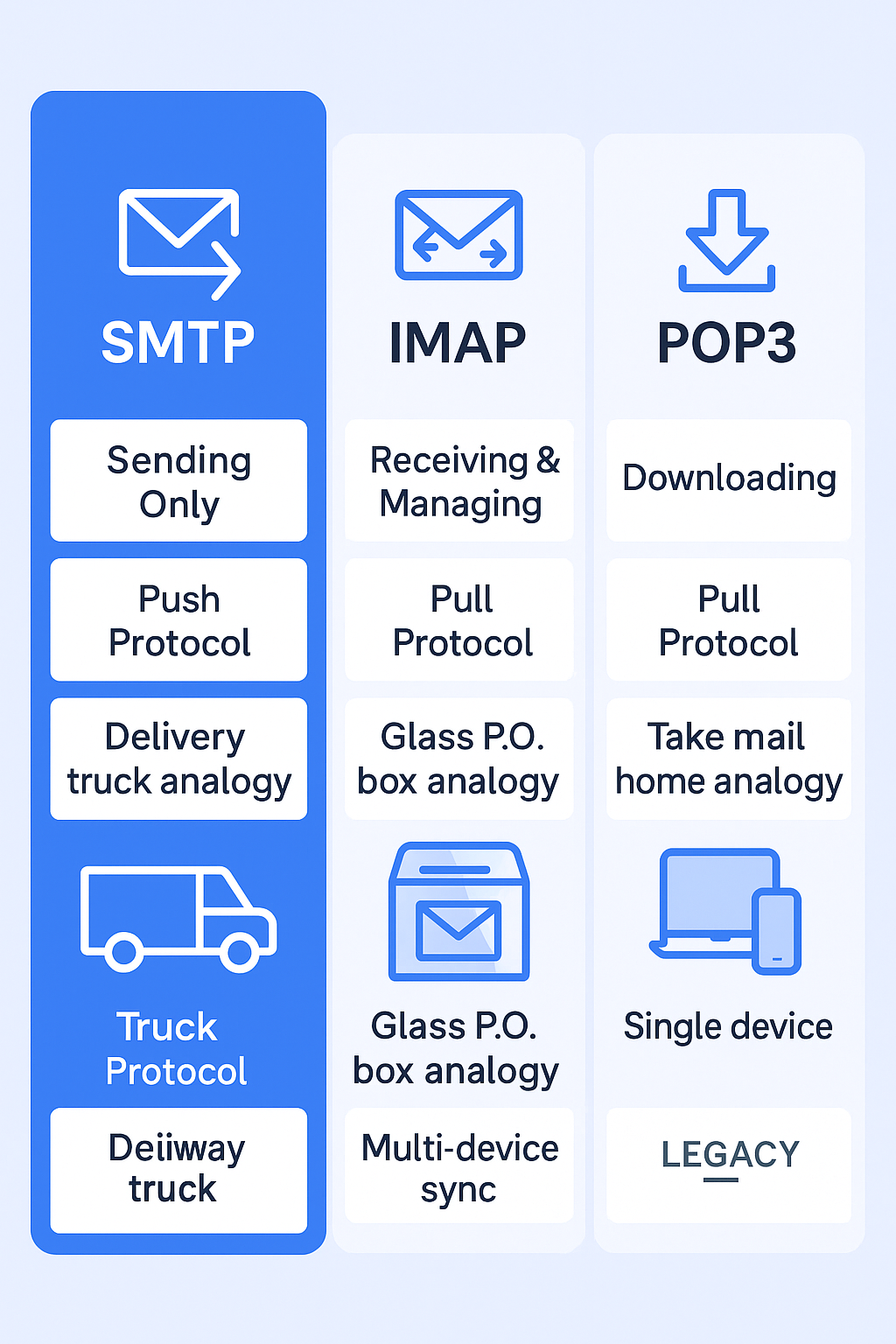- blog
- Cold Emailing
- SMTP Guide: Master Email Delivery for Sales Success in 2025

SMTP: The Complete Guide for Sales Professionals Who Want Their Emails to Actually Land in Inboxes
Table of Contents
Picture this: You’ve crafted the perfect cold email sequence. Your copy is sharp, your value proposition compelling, and your prospect list is carefully curated. You hit “send” on 1,000 emails, expecting a flood of replies and booked meetings. Instead? Crickets. No bounces, no replies, just deafening silence. Sound familiar?
If you’re nodding your head, you’re not alone. Here’s the shocking truth: 1 in 6 marketing emails never reach the intended recipient’s inbox, with an average email deliverability rate of just 83.1% across major email service providers.
The culprit? A misunderstood but critically important protocol called SMTP – Simple Mail Transfer Protocol.

As a BDR or AE, understanding SMTP isn’t just technical jargon – it’s the difference between hitting your quota and watching your carefully crafted emails vanish into the digital void. With email marketing delivering an average ROI of $36 for every $1 spent, ensuring your emails actually reach prospects isn’t just important – it’s essential for revenue growth.
In this guide, we’ll demystify SMTP and show you exactly how to leverage it for better deliverability, higher open rates, and ultimately, more closed deals.
What is SMTP?
SMTP (Simple Mail Transfer Protocol) is the standard communication protocol that governs how emails are sent and received across the internet. Think of it as the postal service for digital messages – it ensures your emails get from point A (your outbox) to point B (your prospect’s inbox).
Originally developed in the early 1980s, SMTP has become the backbone of email communication worldwide. Every time you hit “send” on an email, SMTP springs into action, routing your message through a network of servers until it reaches its destination.
Here’s what makes SMTP so crucial for sales professionals:
- Universal Standard: Every email system speaks SMTP, ensuring compatibility across different platforms
- Reliability: Built-in retry mechanisms ensure messages don’t get lost due to temporary server issues
- Security: Modern SMTP includes authentication and encryption features to protect your messages
- Scalability: Can handle everything from single emails to massive cold outreach campaigns
SMTP Full Form and Core Function
The SMTP protocol full form – Simple Mail Transfer Protocol – tells you exactly what it does: it’s a simple, standardized way to transfer mail between servers. But don’t let the word “simple” fool you – while the concept is straightforward, proper SMTP implementation can mean the difference between inbox placement and spam folder burial.
What is ESMTP?
ESMTP (Extended Simple Mail Transfer Protocol) is the modern evolution of SMTP that most email systems use today. The key difference? ESMTP introduced the EHLO command, which allows email servers to advertise their capabilities and support advanced features like:
- Authentication mechanisms (preventing spam and spoofing)
- Encryption support (keeping your prospect data secure)
- Larger message sizes (for those detailed proposals)
- Enhanced error reporting (better troubleshooting)
When your email client connects to an SMTP server today, it’s almost certainly using ESMTP. This extended protocol is what enables modern features like secure login, encrypted connections, and better spam filtering.
What is SMTPS?
SMTPS isn’t actually a separate protocol – it’s SMTP with SSL/TLS encryption wrapped around it. Think of it as SMTP wearing a bulletproof vest. There are two ways to implement SMTPS:
Implicit SMTPS (Port 465)
The entire SMTP conversation happens over an encrypted connection from start to finish. It’s like having a secure phone line where everything is automatically encrypted.
Explicit SMTPS (STARTTLS on Port 587)
The connection starts unencrypted but upgrades to secure using the STARTTLS command. This is the modern standard because it’s more flexible – if encryption isn’t available, the connection can still proceed (though most professional services require encryption).
For BDRs and AEs, using SMTPS is non-negotiable. It protects sensitive prospect information and prevents your emails from being flagged as insecure by modern spam filters.
Types of SMTP
Understanding the different types of SMTP setups helps you choose the right approach for your sales outreach:
Cloud-Based SMTP Services
These are third-party providers that handle the technical heavy lifting:
- Examples: SendGrid, Mailgun, Amazon SES, Postmark
- Best For: High-volume cold outreach campaigns
- Pros: Professional infrastructure, dedicated IPs, advanced analytics
- Cons: Monthly costs, setup complexity
Built-in Email Provider SMTP
Your standard email service’s smtp server:
- Examples: Gmail SMTP, Outlook SMTP, Yahoo SMTP
- Best For: Low-volume, day-to-day communication
- Pros: Free, easy setup, integrated with existing email
- Cons: Strict sending limits (typically 500 emails/day), shared reputation
On-Premise SMTP Servers
Company-owned mail servers:
- Best For: Large enterprises with dedicated IT teams
- Pros: Complete control
- Cons: Expensive, complex, requires technical expertise
For most sales teams, cloud-based SMTP services offer the best balance of deliverability, scalability, and cost-effectiveness.
SMTP Infrastructure
Modern SMTP infrastructure consists of several key components working together to ensure reliable email delivery:
SMTP Server Architecture
An SMTP server is the engine that powers email delivery. Professional smtp servers typically include:
- Load balancers to distribute email traffic
- Queue management systems to handle high volumes
- Reputation monitoring to maintain sender credibility
- Bounce handling to process failed deliveries
- Analytics dashboards for performance tracking
IP Reputation Management
Your sending IP address has a reputation score that directly impacts deliverability. Here’s what affects it:
- Bounce rates (keep below 5%)
- Spam complaints (aim for under 0.1%)
- Engagement rates (opens, clicks, replies)
- Sending volume consistency
- Authentication compliance (SPF, DKIM, DMARC)
Recent data shows that the biggest changes in email deliverability rates are seen with major providers, with some experiencing drops of over 27% year-over-year, making IP reputation management more critical than ever.
Mail Agents
The SMTP ecosystem involves several specialized agents that handle different aspects of email delivery:
MUA (Mail User Agent)
Your email client – Outlook, Gmail interface, or sales engagement platform like Saleshandy or Smartlead.
MSA (Mail Submission Agent)
Receives your email from the MUA and performs initial validation before passing it to the MTA.
MTA (Mail Transfer Agent)
The workhorse that actually transfers emails between servers using the SMTP protocol.
MDA (Mail Delivery Agent)
Places the email in the recipient’s mailbox for retrieval via IMAP or POP3.
Understanding these agents helps you troubleshoot email delivery issues and optimize your sending setup.
SMTP Relay
SMTP relay is the process of forwarding emails through intermediate servers to reach their final destination. For sales professionals, SMTP relay services are a life saver because they:
Handle High-Volume Sending
Standard email providers limit you to 500-1,000 emails per day. Professional smtp relay services can handle thousands or tens of thousands of emails daily.
Maintain Sender Reputation
Quality SMTP relay providers monitor their IP addresses and take proactive steps to maintain high deliverability rates.
Provide Detailed Analytics
Track delivery rates, open rates, bounce rates, and spam complaints in real-time.
Offer Advanced Features
- Email scheduling and throttling
- A/B testing capabilities
- Automated bounce handling
- Integration with CRM systems
Popular SMTP relay services include SendGrid, Mailgun, and Amazon SES, each offering different strengths for different use cases.
How Does SMTP Work?
Understanding the SMTP workflow helps you optimize your email setup and troubleshoot delivery issues. Here’s what happens when you send an email:
Step 1: Email Composition and Submission
You write your email in your mail client and hit send. Your MUA connects to your configured SMTP server (usually on port 587 for secure submission).
Step 2: SMTP Handshake
Your email client and the SMTP server have a conversation:
- Client: EHLO mydomain.com (Hello, I’m here)
- Server: 250 OK (Great, what can I do for you?)
- Client: MAIL FROM:<you@yourdomain.com> (This email is from…)
- Server: 250 OK (Got it)
- Client: RCPT TO:<prospect@theirdomain.com> (It’s going to…)
- Server: 250 OK (Understood)
- Client: DATA (Here comes the message)
- Server: 354 Start mail input (Ready for content)
- Client: [Sends email headers and body]
- Server: 250 OK Message accepted (Message received)
- Client: QUIT (Goodbye)
Step 3: DNS Lookup and Routing
The SMTP server looks up the recipient domain’s MX (Mail Exchange) record to find their mail server’s IP address.
Step 4: Message Relay
Your SMTP server connects to the recipient’s mail server and repeats a similar handshake to deliver the message.
Step 5: Final Delivery
The recipient’s MDA places the email in their mailbox, where it can be retrieved via IMAP or POP3.
This entire process typically happens in seconds, but understanding it helps you identify where delivery issues might occur.
🎯 Skip The Technical Stack
LinkedIn outbound reaches 65M+ decision makers without SMTP configuration or servers
What About the SMTP Queue?
The SMTP queue is your email’s waiting room – a temporary storage area where messages sit before being sent or retried after temporary failures.
Why Emails Get Queued
Temporary Server Issues: If the recipient’s server is busy or temporarily down, your email gets queued for retry later.
Rate Limiting: Professional SMTP services queue emails to send them at controlled rates, preventing your domain from being flagged for suspicious activity.
Volume Management: Large campaigns are automatically queued and sent over time to maintain optimal deliverability.
Authentication Delays: If authentication checks take longer than expected, emails wait in queue.
Queue Management Best Practices
- Monitor queue length: Long queues may indicate reputation issues
- Set appropriate retry intervals: Too frequent retries can hurt your reputation
- Implement proper bounce handling: Remove invalid addresses quickly
- Use dedicated IPs for high-volume sending: Shared IPs can experience queue delays
A well-managed SMTP queue ensures consistent delivery and protects your sender reputation.
SMTP Commands and Responses
Understanding SMTP commands helps you troubleshoot email issues and optimize your sending setup.
Essential SMTP Commands
EHLO/HELO: Initiates the SMTP session and identifies the sending server MAIL FROM: Specifies the sender’s email address
RCPT TO: Specifies the recipient’s email address DATA: Indicates the start of the message content STARTTLS: Upgrades the connection to encrypted AUTH: Authenticates the sender using credentials QUIT: Ends the SMTP session
SMTP Response Codes
SMTP servers respond with three-digit codes that indicate success or failure:
Common Positive Responses
220: Service ready (server is ready to receive commands) 250: Requested action completed successfully
354: Start mail input (server is ready to receive message content) 221: Service closing transmission channel (goodbye)
Negative Responses or Error Codes
421: Service not available (temporary failure – try again later) 450: Mailbox temporarily unavailable (recipient server is busy) 550: Mailbox unavailable (email address doesn’t exist) 552: Exceeded storage allocation (recipient’s mailbox is full) 554: Transaction failed (message rejected for policy reasons)
Pro Tip: 4xx codes are temporary failures that warrant retries, while 5xx codes are permanent failures that require immediate attention.
SMTP Ports
Choosing the right SMTP port is crucial for successful email delivery. Here are the ports you need to know:
Port 25 (Server-to-Server Relay)
- Use Case: Communication between mail servers
- Security: Usually unencrypted
- Availability: Blocked by most ISPs for client connections
- Recommendation: Never use for sending emails from your sales tools
Port 465 (SMTPS – Deprecated)
- Use Case: Legacy secure SMTP
- Security: Implicit SSL/TLS encryption
- Status: Officially deprecated but still supported by some providers
- Recommendation: Use only if specifically required by your email provider
Port 587 (Modern Standard)
- Use Case: Email submission from clients to servers
- Security: STARTTLS encryption (explicit)
- Authentication: Required
- Recommendation: Use this port for all your sales email tools
Port 2525 (Alternative)
- Use Case: Alternative to 587 when it’s blocked
- Security: STARTTLS encryption
- Availability: Offered by many SMTP relay services
- Recommendation: Use as backup if 587 doesn’t work
For BDRs and AEs: Always configure your email tools to use Port 587 with STARTTLS encryption.

This ensures maximum compatibility and security.
💼 Zero Port Configuration
LinkedIn messaging delivers without choosing ports, encryption types, or relay services
Comparing SMTP, IMAP, and POP3
Understanding the difference between these protocols prevents common configuration mistakes:
SMTP (Simple Mail Transfer Protocol)
- Purpose: Sending emails only
- Direction: Outbound (push protocol)
- Function: Transfers messages from your email client to servers
- Analogy: The delivery truck that takes your mail to the post office
IMAP (Internet Message Access Protocol)
- Purpose: Receiving and managing emails
- Direction: Inbound (pull protocol)
- Function: Keeps emails on the server, syncs across multiple devices
- Analogy: A glass P.O. box you can see and organize from anywhere
- Best For: Modern sales professionals who check email on phone, laptop, and desktop
POP3 (Post Office Protocol 3)
- Purpose: Downloading emails
- Direction: Inbound (pull protocol)
- Function: Downloads emails to one device, then deletes from server
- Analogy: Taking all your mail home from the post office
- Best For: Single-device users (rarely recommended today)
Key Takeaway: You need SMTP for sending and IMAP for receiving. They work together but serve different functions.

How to Send Emails with SMTP
Setting up SMTP for your sales tools involves several key steps:
Basic SMTP Configuration
Most email clients and sales platforms require these settings:
SMTP Server: Your provider’s server address (e.g., smtp.gmail.com) Port: 587 (preferred) or 465 Encryption: STARTTLS or SSL/TLS Authentication: Username and password or API key Sender Address: Your “from” email address
Gmail SMTP Setup
For Gmail/Google Workspace accounts:
- SMTP Server: smtp.gmail.com
- Port: 587
- Encryption: STARTTLS
- Username: Your full Gmail address
- Password: App-specific password (if 2FA enabled)
Professional SMTP Setup
For high-volume cold email:
- Choose an SMTP relay service (SendGrid, Mailgun, etc.)
- Configure domain authentication (SPF, DKIM, DMARC)
- Set up dedicated IP (for better reputation control)
- Implement proper warm-up (gradually increase sending volume)
- Monitor deliverability metrics (bounces, complaints, opens)
WordPress Integration
For businesses using WordPress websites, the WP Mail SMTP plugin is essential. It routes all website-generated emails (contact forms, password resets, order confirmations) through a professional SMTP provider instead of unreliable PHP mail functions.
This ensures critical business communications actually reach your customers and prospects.
SMTP as a Service: Testing and Sending
Modern SMTP services go far beyond basic email delivery:
Key Features to Look For
Dedicated IP Addresses: Control your own sender reputation Advanced Analytics: Track delivery, opens, clicks, and bounces in real-time
API Integration: Connect with your CRM and sales tools Template Management: Store and manage email templates A/B Testing: Optimize subject lines and content Bounce Management: Automatically handle failed deliveries Spam Testing: Check emails before sending to avoid spam filters
Testing Your SMTP Setup
Before launching campaigns, test your configuration:
- Send test emails to multiple email providers (Gmail, Outlook, Yahoo)
- Check spam folder placement across different services
- Verify authentication (SPF, DKIM, DMARC passing)
- Test bounce handling with invalid email addresses
- Monitor delivery speed and queue processing times
Popular SMTP Service Providers
SendGrid: Excellent for marketing emails, strong analytics Mailgun: Developer-friendly, powerful APIs, good for transactional email
Amazon SES: Cost-effective for high volumes, technical setup required Postmark: Premium deliverability, excellent for transactional messages SMTP.com: Great customer support, good for small to medium businesses
Choose based on your volume, technical expertise, and budget requirements.
Advanced SMTP Best Practices for Sales Teams
Domain Authentication Setup
SPF (Sender Policy Framework): Authorizes specific IP addresses to send email for your domain DKIM (DomainKeys Identified Mail): Adds digital signatures to verify email authenticity
DMARC (Domain-based Message Authentication): Tells receiving servers what to do with unauthenticated emails
Recent industry data shows an 11% increase in DMARC adoption in 2024, with nearly 54% of senders now implementing it – making proper authentication more critical than ever.
📊 No Authentication Required
Complete LinkedIn system: targeting, campaigns, engagement—without SPF, DKIM, or DMARC
List Hygiene and Bounce Management
Maintain your sender reputation by:
- Verifying email addresses before adding to campaigns (verify email addresses properly)
- Monitoring bounce rates (keep below 5%)
- Handling spam complaints immediately (aim for under 0.1%)
- Segmenting engaged users for better targeting
Volume and Timing Optimization
Start Slow: Begin with 50-100 emails per day and gradually increase Maintain Consistency: Send similar volumes at regular intervals Respect Time Zones: Send emails when prospects are most likely to engage Monitor Engagement: Track opens, clicks, and replies to optimize timing
Integration with Sales Tools
Connect your SMTP setup with:
- CRM Systems: Sync email activity and responses
- Sales Engagement Platforms: Automate follow-up sequences
- Analytics Tools: Track campaign performance and ROI
- Lead Generation Tools: Import and manage prospect lists
Troubleshooting Common SMTP Issues
Authentication Failures (535 Error)
Cause: Incorrect username, password, or server settings Solution: Double-check credentials, enable “less secure apps” if needed, or use app-specific passwords
High Bounce Rates
Cause: Invalid email addresses or poor list quality Solution: Use email verification tools, clean your lists regularly, and understand email bounce-back issues
Spam Folder Placement
Cause: Poor sender reputation, authentication issues, or spammy content Solution: Implement proper authentication, warm up your domain, and avoid spam trigger words
Slow Delivery or Queue Buildup
Cause: Volume limits, rate limiting, or reputation issues Solution: Reduce sending volume, improve engagement rates, or switch to a dedicated IP
Connection Timeouts
Cause: Network issues, incorrect port settings, or firewall blocking Solution: Try alternative ports (2525), check firewall settings, or contact your ISP
The ROI Impact of Proper SMTP Setup
🚀 Guaranteed Delivery System
LinkedIn outbound operates with 99% delivery rate without bounce handling or troubleshooting
7-day Free Trial |No Credit Card Needed.
Getting SMTP right directly impacts your bottom line:
Deliverability Improvements
- Inbox placement: From 60% to 95%+ with proper setup
- Open rates: Can increase by 30-50% when emails reach the inbox
- Response rates: Higher deliverability leads to more conversations
Cost Savings
- Reduced bounce costs: Fewer wasted emails on invalid addresses
- Better tool efficiency: Your sales engagement platform performs better
- Time savings: Less time troubleshooting delivery issues
Revenue Growth
With email marketing delivering $36 for every $1 spent and 52% of consumers making purchases directly from emails, proper SMTP setup can significantly impact your sales results.
Conservative estimate: A 20% improvement in deliverability can translate to a 20% increase in pipeline generation from email outreach.
Future of SMTP and Email Delivery
The email landscape continues evolving with new security requirements and authentication standards:
2024 Authentication Requirements
Major providers now require:
- SPF, DKIM, and DMARC implementation for bulk senders
- Spam complaint rates below 0.3%
- Proper unsubscribe mechanisms
- Sender identity verification
Emerging Trends
- AI-powered spam filtering becoming more sophisticated
- Increased focus on engagement metrics over traditional reputation signals
- Enhanced mobile optimization requirements
- Privacy-focused authentication methods
Staying ahead of these trends ensures your email outreach remains effective as the landscape evolves.
FAQsFrequently Asked Questions
Can I use my Gmail SMTP server for cold email campaigns?
What's the best SMTP port for cold email?
How do I test if my SMTP server is working?
Why are my emails going to spam despite correct SMTP setup?
Do I need a dedicated IP for SMTP?
Conclusion
SMTP might seem like a technical detail, but for sales professionals, it’s the foundation of successful email outreach. Understanding and properly implementing SMTP can mean the difference between emails that reach prospects and emails that disappear into the digital void.
Key takeaways for BDRs and AEs:
- Use Port 587 with STARTTLS for all your email tools
- Implement proper authentication (SPF, DKIM, DMARC) for your domain
- Choose professional SMTP services for high-volume campaigns
- Monitor deliverability metrics and maintain good list hygiene
- Start with proper warm-up to build sender reputation
With 361.6 billion emails sent daily worldwide and only 83.1% reaching their intended destinations, mastering SMTP gives you a significant competitive advantage.
Don’t let poor email deliverability sabotage your sales success. Invest in proper SMTP setup, monitor your performance, and watch your response rates soar.
Ready to take your email game to the next level? Start with the basics – configure your tools correctly, authenticate your domain, and always prioritize deliverability over volume. Your quota will thank you.

Eliminate Email Infrastructure Complexity
LinkedIn outbound delivers messages without SMTP servers, ports, or authentication

